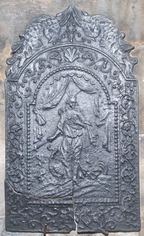-
966
Description: Arched rectangular shape; ovolo moulded edging; date in arch; below arch two parallel, vertical straps, each with a buckle at the top; initials left and right of centre; roughly symmetrical arrangement of four stamps repeated: rectangular stamp with deer three times down centre, one outside each buckle and one beyond each strap end; circular food mould stamp outside centre of each strap, beyond stag stamp outside buckle and at edge beyond strap end; 'rabbit' stamp at edge beyond food mould stamp outside each buckle and outside each strap end; rectangular stamp with 'dog' outside each initial and six times below strap ends.
Notes: The buckles suggest a connection with the Pelham family; the initials may relate to Sir Thomas Pelham, Bt. (1597-1654) who owned and operated ironworks at Waldron in Sussex. From the drawing the seven 'deer' stamps appear to be the same as those seen on two other examples of this fireback. The food mould stamp (centre left and right) appears to be one seen repeated on at least one other fireback. Drawing of a fireback at Huggetts Farm, Waldron, Sussex, by Edward Hughes, of Heathfield, Sussex; J. Starkie Gardner collection, Victoria & Albert Museum, Archive of Art and Design (AAD/2014/8).
Inscription: 1642 / T P
- Decoration tags:
- rectangular with round arch (shape)
- ovolo (edging)
- carved stamps
- whole carved pattern
- individual letters
- text
- animals
- objects
Manufactured: in the mid-17th century probably at Waldron Furnace in the Weald area of England.
Current location: not known.
Citation: Gardner, J. S., 1898, 'Iron Casting in the Weald', Archaeologia, 56, 1, pp. 133-164.
- Attached to series:
- 1642 Pelham series
- Pelham family firebacks
- Food mould stamp firebacks
-
206
Description: Rectangular with two-stepped top; double astragal edging on sides; top centre, stamp formed of a talbot statant guardant upon a wreath; date split either side of crest; initials below date, ‘+’ below letters.
Notes: The talbot crest is seen on other firebacks indicating a common source.
Copies of this fireback are known.
Inscription: 16 22 / I + H
- Decoration tags:
- stepped (shape)
- fillet (edging)
- simple stamps
- carved stamps
- individual numbers
- heraldic
- text
Manufactured: in 1622 in the Weald area of England.
Current location: St Mary's House, Bramber, West Sussex, England.
- Attached to series:
- Talbot crest series
- Stepped firebacks
-
850
Description: Canted rectangle; elaborate cavetto moulded edging (top and sides); strapwork shield with a demi-flower at each side, between initials (S only visible); arms quarterly of six, 1st Or two chevronels Gules, on a canton of the last a mullet of the first (Pope); 2nd Argent three bars Gules, on a canton ermine a bend of lozenges of the second (Walshe); 3rd Sable three laurel leaves in bend Or between two bendlets Argent (Waller); 4th Azure a chevron between three crosses Moline Argent (Lansdale); 5th Ermine on a bend Gules three lions’ heads erased Or (Weston); 6th Azure a lion rampant Or supporting a cross patée fitchée of the second (Pichingham).
Notes: The excrescence over the third quartering is the result of the iron being poured directly onto the mould. The second initial is known from another casting. The date above the shield has been inserted before casting and differs slightly from another example of the same back.
Copies of this fireback are known.
Inscription: 1625 / S [P]
Arms: Pope (Sackevile Pope (b. 1589) of Hendall, in Buxted, Sussex)
- Decoration tags:
- rectangular with canted top corners (shape)
- complex individual (edging)
- whole carved pattern
- date stamp
- armorial
- text
Manufactured: in 1625 in the Weald area of England.
Current location: not known.
- Attached to series:
- Personal armorial firebacks
- Low relief armorial series
-
244
Description: Canted rectangle; twisted rope edging (top and sides); stamp of three ostrich feathers within a coronet, between the two parts of the date, with lion and unicorn supporters outside date.
Notes: The ostrich feathers are the badge of the Prince of Wales. There is no known significance of the year 1629 with that title, the birth of the prince (later Charles II) being in the following year. The date was probably added to a recasting of the plate. The lack of detail in the modelling indicates this has been recast several times.
Copies of this fireback are known.
Inscription: 16 29
- Decoration tags:
- rectangular with canted top corners (shape)
- rope (edging)
- carved stamps
- individual numbers
- heraldic
- text
- animals
Manufactured: in 1629 in the Weald area of England.
Current location: in private hands, Chailey, East Sussex, England.
Citation: Lloyd, N., 1925, 'Domestic Ironwork I', Architectural Review, 58, pp. 58-67.
- Attached to series:
- Prince of Wales' feathers series
- Prince of Wales firebacks
-
896
Description: Arched rectangular shape; no edging; three 'daisy' flowerheads, top centre and in each shoulder; central plume of six ostrich feathers issuing from what appears to be a wreath surmounting a tree stump.
Notes: Excavated from the ruins of Cloughoughter Castle in County Cavan, which had been rendered uninhabitable in a siege of 1653. Until the early 16th century the castle had been in the hands of the O'Reilly family. On some versions of the O'Reilly arms the crest is shown as a plume of ostrich feathers, although this may be a misrepresentation of the usual crest of a tree with a snake entwined about it.
- Decoration tags:
- rectangular with round arch (shape)
- none (edging)
- carved stamps
- heraldic
- plants
Manufactured: in the early-17th century in Ireland.
Current location: Parke's Castle, Fivemile Bourne, Co. Leitrim, Ireland.
(part of the Heritage Ireland museum group)
- Attached to series:
- Miscellaneous stamp firebacks
-
1132
Description: Cavetto-canted arched rectangular shape; rebated wide fillet edging; shield of Llewellyn impaling unidentified arms: (Llewellyn) Per fesse embattled, azure and or, a javelin erect, between two boars' heads erased in chief, and a like boar's head between two javelins in base, all counterchanged; below, scroll bearing the motto, Gwell angau na Chywilydd (Death before Dishonour), possibly inscribed after casting.
Notes: The arms were granted to Robert William Llewellyn of Court Colman and Baglan Hall, Glamorgan, in 1902.
Inscription: Gwell angau na Chywilydd {Better death than shame]
Arms: Llewellyn, of Court Colman, Glamorgan
- Decoration tags:
- rectangular with canted top corners and round arch (shape)
- fillet (edging)
- whole carved pattern
- heraldic
- armorial
- text
Manufactured: in the early-20th century in Wales.
Current location: Gallops Architectural, Ty-r-Ash, Brecon Road, Crickhowell, Powys, Wales.
- Attached to series:
- Personal armorial firebacks
-
298
Description: Pentagonal with a small triangular arch, centre top; twisted rope edging (top and sides); in arch, cross formed of small fleurs-de-lys; row of small fleurs inside rope edging, lower half of sides plain; length of twisted rope each side, parallel to edges, with small fleur terminal at top end; upper centre, rope escarbuncle with fleur terminals between ‘R’ and ‘C’ (both of rope with fleur terminals, ‘R’ reversed); ‘A’ below escarbuncle (also rope with fleur terminals, with cross bar above); fleur cross below ‘R’.
Notes: Twisted rope with fleur terminals is seen on several firebacks with stamps otherwise associated; it is a form paralleled on firebacks from the Champagne area of France. The escarbuncle is the principal charge on the arms of the Duchy of Cleves, possibly associating this fireback with the brief marriage of Henry VIII and Anne of Cleves. Formerly at Warnham Court, Sussex; illustrated in Gardner 1898, p. 146.
Inscription: R A C [inverted triad]
- Decoration tags:
- rectangular with canted top corners and triangular arch (shape)
- rope (edging)
- simple stamps
- objects
Manufactured: in the mid- to late-16th century possibly at Pounsley Furnace, Framfield in the Weald area of England.
Current location: not known.
Citation: Gardner, J. S., 1898, 'Iron Casting in the Weald', Archaeologia, 56, 1, pp. 133-164.
-
324
Description: Rectangular with two-stepped top; undefined edging; in arch, stamp formed of a talbot statant guardant upon a wreath; date below crest; vertical carved billet stamped three times, the centre one higher than the other two, between the initials, below each pair of which is a cross stamp.
Notes: The talbot crest is seen on other firebacks indicating a common source; from a drawing in report 2553 of the Domestic Buildings Research Group (Surrey). The fireback is obscured behind a stove.
Inscription: 16 30 / IM EM
- Decoration tags:
- stepped (shape)
- simple stamps
- carved stamps
- heraldic
- text
- objects
Manufactured: in 1630 in the Weald area of England.
Current location: in private hands, Horne, Surrey, England.
- Attached to series:
- Talbot crest series
- Stepped firebacks
-
358
Description: Arched rectangular central panel with bead edging on a broad fillet; standing on a ground with a peacock behind her, a classically-dressed figure of a female, wearing a crown and holding a sceptre in her right hand, her left hand across her chest; above her, swagged drapery; arched rectangular border with fillet edging; central scallop shell at the top with a descending arrangement of swirled and interlinked lines; at bottom centre, a cartouche bearing the letter ‘N’; on top, two mirrored serpents.
Notes: The figure is that of Hera/Juno. The pattern maker identified as ‘N’ is likely to have been working in collaboration with pattern makers whose fireback designs are identified with the initials, SHR and EB, and with the maker responsible for patterns made in 1724, some of which bore inscriptions in Welsh.
Inscription: N
- Decoration tags:
- 'Dutch' (shape)
- fillet (edging)
- whole carved pattern
- pictorial
- mythological
- text
- animals
- humans
Manufactured: in the early-18th century in England.
Current location: Baddesley Clinton Hall, Knowle, Warwickshire, England.
Museum number: 342886 (part of the National Trust museum group)
- Attached to series:
- N series
- British 'Dutch' style firebacks
-
418
Description: Cavetto-arched rectangular central panel with bead-and-pellet edging, head and robed shoulders of a laureated man in left profile; cavetto-arched rectangular border with cavetto-moulded edging and arrangement of outward-facing acanthus leaves; on top, scallops on shoulders of border with cornucopiae over arch.
Notes: A pastiche of the 'Dutch' style of fireback. Formerly part of the J. H. Every collection.
- Decoration tags:
- 'Dutch' (shape)
- bead-and-pellett (edging)
- whole carved pattern
- pictorial
- humans
Manufactured: in the early-18th century in England.
Current location: Anne of Cleves House, Southover High Street, Lewes, East Sussex, England.
Museum number: 1944.24.090 (part of the Sussex Archaeological Society museum group)
- Attached to series:
- Miscellaneous pattern firebacks
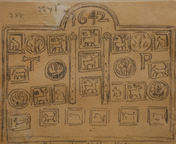

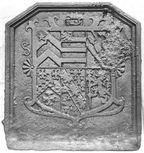
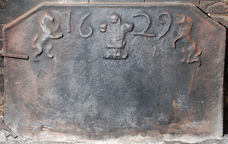
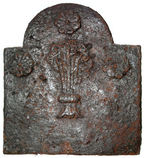

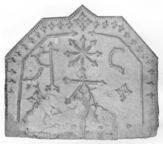
.jpg)
